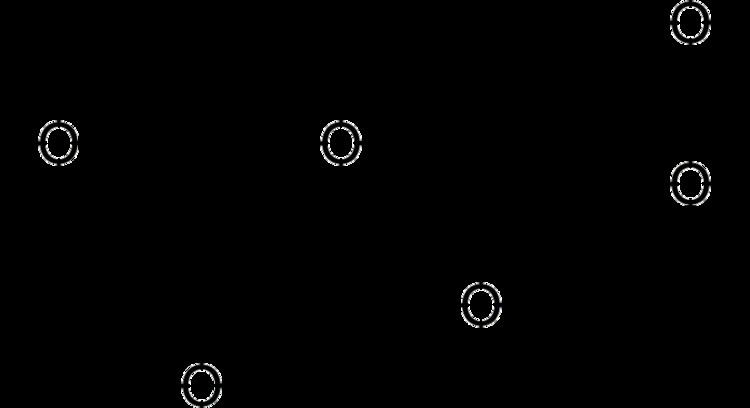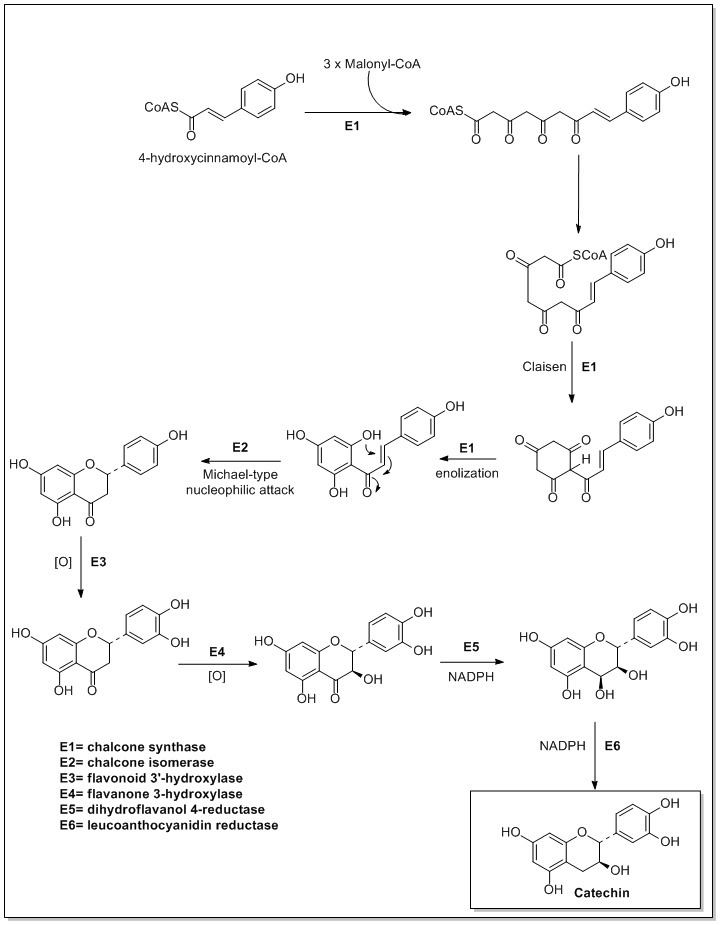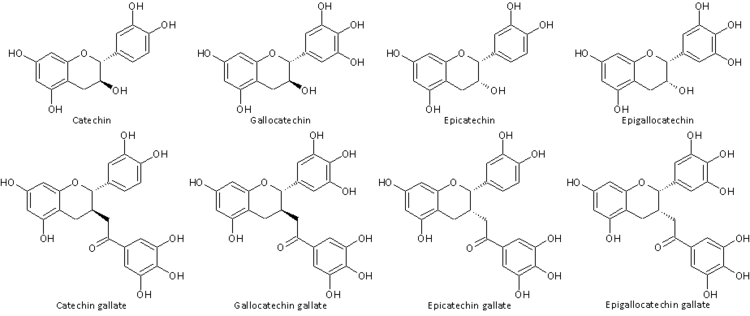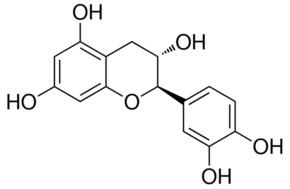Formula C15H14O6 Melting point 175 °C | Molar mass 290.26 g/mol Appearance Colorless solid | |
 | ||
IUPAC ID (2R,3S)-2-(3,4-dihydroxyphenyl)-3,4-dihydro-2H-chromene-3,5,7-triol | ||
Catechin /ˈkætᵻtʃɪn/ is a flavan-3-ol, a type of natural phenol and antioxidant. It is a plant secondary metabolite. It belongs to the group of flavan-3-ols (or simply flavanols), part of the chemical family of flavonoids.
Contents
- Chemistry
- Oxidation
- Natural occurrences
- In food
- Taste
- Biodegradation
- Humans
- Research
- Biotransformation
- Glycosides
- Vascular function
- Possible immune effects
- Botanical effects
- References

The name of the catechin chemical family derives from catechu, which is the tannic juice or boiled extract of Mimosa catechu (Acacia catechu L.f).

Chemistry

Catechin possesses two benzene rings (called the A- and B-rings) and a dihydropyran heterocycle (the C-ring) with a hydroxyl group on carbon 3. The A ring is similar to a resorcinol moiety while the B ring is similar to a catechol moiety. There are two chiral centers on the molecule on carbons 2 and 3. Therefore, it has four diastereoisomers. Two of the isomers are in trans configuration and are called catechin and the other two are in cis configuration and are called epicatechin.

The most common catechin isomer is the (+)-catechin. The other stereoisomer is (-)-catechin or ent-catechin. The most common epicatechin isomer is (-)-epicatechin (also known under the names L-epicatechin, epicatechol, (-)-epicatechol, l-acacatechin, l-epicatechol, epi-catechin, 2,3-cis-epicatechin or (2R,3R)-(-)-epicatechin).
The different epimers can be distinguished using chiral column chromatography.

Making reference to no particular isomer, the molecule can just be called catechin. Mixtures of the different enantiomers can be called (+/-)-catechin or DL-catechin and (+/-)-epicatechin or DL-epicatechin.
Catechin and epicatechin are the building blocks of the proanthocyanidins, a type of condensed tannin.

Moreover, the flexibility of the C-ring allows for two conformation isomers, putting the B ring either in a pseudoequatorial position (E conformer) or in a pseudoaxial position (A conformer). Studies confirmed that (+)-catechin adopts a mixture of A- and E-conformers in aqueous solution and their conformational equilibrium has been evaluated to be 33:67.

As flavonoids, catechins can act as antioxidants when in high concentration in vitro, but compared with other flavonoids, their antioxidant potential is low. The ability to quench singlet oxygen seems to be in relation with the chemical structure of catechin, with the presence of the catechol moiety on ring B and the presence of a hydroxyl group activating the double bond on ring C.
Oxidation

Electrochemical experiments show that (+)-catechin oxidation mechanism proceeds in sequential steps, related with the catechol and resorcinol groups and the oxidation is pH-dependent. The oxidation of the catechol 3′,4′-dihydroxyl electron-donating groups occurs first, at very low positive potentials, and is a reversible reaction. The hydroxyl groups of the resorcinol moiety oxidised afterwards were shown to undergo an irreversible oxidation reaction.
The laccase/ABTS system oxidizes (+)-catechin to oligomeric products of which proanthocyanidin A2 is a dimer.
Natural occurrences
(+)-Catechin and (-)-epicatechin as well as their gallic acid conjugates are ubiquitous constituents of vascular plants, and frequent components of traditional herbal remedies, such as the Chinese medicine plant Uncaria rhynchophylla and others. The two isomers are mostly found as cacao and tea constituents.
(-)-Epicatechin can be found in cacao beans and was first called kakaool or cacao-ol. It was isolated from green tea by Michiyo Tsujimura in 1929. Maximilian Nierenstein was among those who proved the presence of catechin in cocoa beans in 1931.
Catechin is also found as glycoside and the glycosidic form has also antioxidant properties "in vitro".
In food
The main dietary sources of catechins in Europe and the United States are tea and pome fruits.
Catechins and epicatechins are found in cocoa, which, according to one database, has the highest content (108 mg/100 g) of catechins among foods analyzed, followed by prune juice (25 mg/100 ml) and broad bean pod (16 mg/100 g). Açaí oil, obtained from the fruit of the açaí palm (Euterpe oleracea), contains (+)-catechins (67 mg/kg). (-)-Epicatechin and (+)-catechin are among the main natural phenols in argan oil.
Catechins are diverse among foods, from peaches to green tea and vinegar. Catechins are found in barley grain where they are the main phenolic compound responsible for dough discoloration.
Taste
The taste associated with monomeric (+)-catechin or (-)-epicatechin is described as not exactly astringent, nor exactly bitter.
The biosynthesis of catechin begins with a 4-hydroxycinnamoyl CoA starter unit which undergoes chain extension by the addition of three malonyl-CoAs through a PKSIII pathway. 4-hydroxycinnamoyl CoA is biosynthesized from L-phenylalanine through the Shikimate pathway. L-phenylalanine is first deaminated by phenylalanine ammonia lyase (PAL) forming cinnamic acid which is then oxidized to 4-hydroxycinnamic acid by cinnamate 4-hydroyxylase. Chalcone synthase then catalyzes the condensation of 4-hydroxycinnamoyl CoA and three molecules of malonyl-CoA to form chalcone. Chalcone is then isomerized to naringenin by chalcone isomerase which is oxidized to eriodictyol by flavonoid 3’- hydroxylase and further oxidized to taxifolin by flavanone 3-hydroxylase. Taxifolin is then reduced by dihydroflavanol 4-reductase and leucoanthocyanidin reductase to yield catechin. The biosynthesis of catechin is shown below
Leucocyanidin reductase (LCR) uses 2,3-trans-3,4-cis-leucocyanidin to produce (+)-catechin and is the first enzyme in the proanthocyanidins (PA)-specific pathway. Its activity has been measured in leaves, flowers, and seeds of the legumes Medicago sativa, Lotus japonicus, Lotus uliginosus, Hedysarum sulfurescens, and Robinia pseudoacacia. The enzyme is also present in Vitis vinifera (grape).
Biodegradation
Catechin oxygenase, a key enzyme in the degradation of catechin, is present in fungi and bacteria.
Among bacteria, degradation of (+)-catechin can be achieved by Acinetobacter calcoaceticus. Catechin is metabolized to protocatechuic acid (PCA) and phloroglucinol carboxylic acid (PGCA). It is also degraded by Bradyrhizobium japonicum. Phloroglucinol carboxylic acid is further decarboxylated to phloroglucinol, which is dehydroxylated to resorcinol. Resorcinol is hydroxylated to hydroxyquinol. Protocatechuic acid and hydroxyquinol undergo intradiol cleavage through protocatechuate 3,4-dioxygenase and hydroxyquinol 1,2-dioxygenase to form β-carboxy cis, cis-muconic acid and maleyl acetate.
Among fungi, degradation of catechin can be achieved by Chaetomium cupreum.
Humans
Catechins are metabolised upon uptake from the gastrointestinal tract, in particular the jejunum, and in the liver, resulting in so-called structurally-related epicatechin metabolites (SREM). The main metabolic pathways for SREMs are glucuronidation, sulphation and methylation of the catechol group by catechol-O-methyl transferase, with only small amounts detected in plasma. The majority of dietary catechins are however metabolised by the colonic microbiome to gamma-valerolactones and hippuric acids which undergo further biotransformation, glucuronidation, sulphation and methylation in the liver.
The stereochemical configuration of catechins has a strong impact on their uptake and metabolism as uptake is highest for (-)-epicatechin and lowest for (-)-catechin.
Research
Plasma catechin metabolites are present as conjugated forms and mainly constituted by glucuronidated and sulphated derivatives. There are large inter-species differences in metabolism, making comparisons between data from rodents and humans difficult. The primary metabolite of (+)-catechin in rat plasma is a glucuronide in the nonmethylated form. In contrast, the primary metabolites of (-)-epicatechin in rat plasma are glucuronide and sulfoglucuronide in nonmethylated forms, and sulfate in the 3'-O-methylated forms (3'OMC). The recent use of radiocarbon-labeled epicatechin (14C2-(−)-epicatechin) demonstrated significant species-dependent differences in the metabolism of (-)-epicatechin in rat, mouse and human.
In rats, the concentrations of catechin derivatives in the liver are lower than in plasma, and no accumulation is observed after adaptation for 14 days to the supplemented diets. The hepatic metabolites are intensively methylated (90–95%), but in contrast to plasma, some free aglycones can be detected. Rats fed with (+)-catechin and (-)-epicatechin exhibit (+)-catechin 5-O-β-glucuronide and (-)-epicatechin 5-O-β-glucuronide in their body fluids. Catechin is absorbed into intestinal cells and metabolized extensively because no native catechin can be detected in plasma from the mesenteric vein. Additional methylation and sulfation occur in the liver, and glucuronide or sulfate conjugates of 3'OMC are excreted extensively in bile. Circulating forms are mainly glucuronide conjugates of catechin and 3'OMC. Another study shows that catechin undergoes enzymatic oxidation by tyrosinase in the presence of glutathione (GSH) to form mono-, bi-, and tri-glutathione conjugates of catechin and mono- and bi-glutathione conjugates of a catechin dimer.
In the crab-eating macaque (Macaca iris), (+)-catechin administered orally or intraperitonally leads to the formation of 10 metabolites and notably to m-hydroxyphenylhydracrylic acid excreted in the urine.
Biotransformation
Biotransformation of (+)-catechin into taxifolin by a two-step oxidation can be achieved by Burkholderia sp.
(+)-Catechin and (-)-epicatechin are transformed by the endophytic filamentous fungus Diaporthe sp. into the 3,4-cis-dihydroxyflavan derivatives, (+)-(2R,3S,4S)-3,4,5,7,3',4'-hexahydroxyflavan (leucocyanidin) and (-)-(2R,3R,4R)-3,4,5,7,3',4'-hexahydroxyflavan, respectively, whereas (-)-catechin and (+)-epicatechin with a 2S-phenyl group resisted the biooxidation.
Leucoanthocyanidin reductase (LAR) uses (2R,3S)-catechin, NADP+ and H2O to produce 2,3-trans-3,4-cis-leucocyanidin, NADPH, and H+. Its gene expression has been studied in developing grape berries and grapevine leaves.
Glycosides
Vascular function
Centuries ago, catechin-containing extracts were thought to be useful for treating heart diseases, and an effect on the permeability of capillaries was shown in 1936. Limited evidence from dietary studies indicates that catechins may have an effect on endothelium-dependent vasodilation which could contribute to normal blood flow regulation in humans. Green tea catechins may improve blood pressure, especially when systolic blood pressure is above 130 mmHg. Due to extensive metabolism during digestion, the fate and activity of catechin metabolites responsible for this effect on blood vessels, as well as the actual mode of action, are unknown.
The European Food Safety Authority established that cocoa flavanols have an effect on vascular function in healthy adults by concluding: "cocoa flavanols help maintain endothelium-dependent vasodilation, which contributes to normal blood flow". Data from observational cohort studies have not shown a consistent association between flavan-3-ol intake and risk of cardiovascuar diseases.
A meta-analysis also indicated that green tea catechins may favorably affect cholesterol.
Possible immune effects
Depending on dose consumed, catechins and their metabolites can bind to red blood cells and possibly induce release of autoantibodies, resulting in haemolytic anaemia and renal failure. This resulted in the withdrawal of the catechin-containing drug, Catergen, used to treat viral hepatitis from the European market in 1985.
Botanical effects
Catechins released into the ground by some plants may hinder the growth of their neighbors, a form of allelopathy. Centaurea maculosa, the spotted knapweed often studied for this behavior, releases catechin isomers into the ground through its roots, potentially having effects as an antibiotic or herbicide. One hypothesis is that it causes a reactive oxygen species wave through the target plant's root to kill root cells by apoptosis. Most plants in the European ecosystem have defenses against catechin, but few plants are protected against it in the North American ecosystem where Centaurea maculosa is an invasive, uncontrolled weed.
Catechin acts as an infection-inhibiting factor in strawberry leaves. Epicatechin and catechin may prevent coffee berry disease by inhibiting appressorial melanization of Colletotrichum kahawae.
